My work encourages me to attend training seminars once in a while to keep up with technology developments. Since there aren't many educational opportunities of this type in western Colorado, I usually need to travel at least as far as Denver. Last July, the closest location for the class I wanted to take, in Microsoft SQL Server 2000 database administration, was in Phoenix. I gave some consideration to the idea of being in Phoenix in July, but I thought, how bad can it be? It's a dry heat, right? And I'll just be driving an air-conditioned car from my air-conditioned hotel room to the air-conditioned training center. Well I'm here to tell you that it's hot in Phoenix in July, no matter how much you try to avoid it. It turned out that my hotel was just six blocks from the training center, so I decided I should walk back and forth for the exercise. This wasn't so bad in the morning, but one afternoon on the walk back it was 112 degrees. I had never experienced heat like that except in a sauna. It made my eyes wobble. Or maybe it was just the heat waves radiating off of everything. When I made it back to my room, I had to take a cold shower just to get my body temperature back to normal.
A major reason I wanted to attend a training in Phoenix, even in July, was that one of my best buddies from high school, Gene Hanson, and his wife Cindy live there. I arranged to fly in early on the Saturday morning before the training's Monday start so we could spend some time together. Even though they live within easy driving distance, Gene and Cindy had never been up to Winslow to see either the Eagles "Take It Easy" tribute or the nearby Meteor Crater, so I suggested that we do exactly that. Gene was up for it but Cindy was not. Just the geeks then!
Here are a few of the photos from that day and the days that followed (click for larger views):
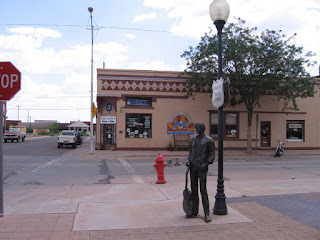
"Well, I'm a-standing on a corner
in Winslow, Arizona
I'm such a fine sight to see
It's a girl, my Lord, in a flatbed Ford
slowin' down to take a look at me
Come on, baby, don't say maybe
I gotta know if your sweet love
is gonna save me
We may lose and we may win
though we will never be here again
so open up, I'm climbin' in, take it easy..."
Winslow seems to have only three things going for it: the railroad runs through it, Route 66 used to run through it, and the Eagles mentioned it in a song. It's a pretty grim little town otherwise.
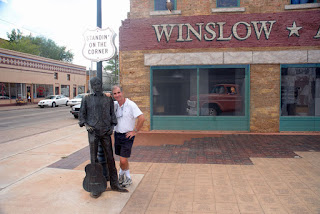
They did a nice job with the tribute, combining a three-dimensional statue with a two-dimensional mural. Here's Gene posing with Take It Easy guy while the girl in a flatbed Ford looks on from the reflection in the painted window. The paving stones contain the names of the people and businesses who contributed to make it all possible.
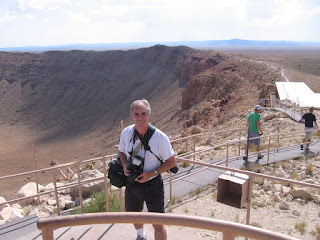
Ready for anything, Gene has all his camera equipment within easy reach at the north rim of the Meteor Crater, about 20 miles west of Winslow on I-40. We didn't know what to expect when we got there. I had seen "Starman", the 1984 movie starring Jeff Bridges and Karen Allen, which has its climax at the crater. That scene made the area look pretty rustic, like there was nothing manmade out there, not even a fence. So we were pleasantly surprised to find a first-class visitor center, with a museum, an American Astronauts Wall of Fame and Apollo space capsule, paved walkways, observation platforms and everything else you would need to complete the experience.

I told Gene, who is a prominent amateur astronomer, that this picture of me could just as easily have been taken on the moon. He laughed and said, "Sure, if you took away the atmosphere and put on a spacesuit." Good points. (Check out Gene's Variable Star website at
GeneHanson.com.)
Quick history: About 50,000 years ago, a meteor weighing hundreds of thousands of tons blasted through the atmosphere above what is now Paris, France. A mere six seconds later, it crashed into the earth at this spot, killing all life within an area about the size of Arizona. In the early 1900s, when area settlers determined that the crater was not a sinkhole or extinct volcano but rather an actual meteorite crater, they excavated in search of the meteorite to claim its iron, but it was never found. "Why do you think that was?" Gene asked. "Did it vaporize on impact?" I asked. "No," he said. "It was moving so fast when it hit the earth that it punched right through the crust and into the mantle." It boggles the mind to imagine that level of destruction. And this is considered a minor impact compared to the one that wiped out the dinosaurs.

Gene using the observation scope to check out the bottom of the crater, which is 550 feet deep and 4000 feet in diameter. The Apollo astronauts did some training here, and there is now a life-size plywood cutout of an astronaut with an American flag down at the bottom, but you can't see it without binoculars or a telescope, which gives a good idea of the scale of the crater. It's huge!

One of the Meteor Crater rangers getting a group together to do the out and back rim tour. Note the two gallon jugs of water--it's hot out there!
He's leaning on a cast of an actual meteorite. Also note the aerial photo of the Meteor Crater in the background. The Visitor Center is that tiny square just northeast of the woman's shoulder. Again, the scale is just incredible.
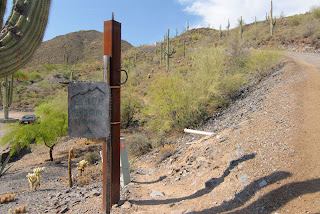
The next morning, Gene and I began our tour of the local hikes that he does to stay in shape for his Grand Canyon hikes. He and a friend hiked/ran from the North Rim to the South Rim in one day a few years ago. You can see photos of the event on Gene's website. This is the start of the Black Mountain Trail, as indicated by the sign. That's the peak of Black Mountain immediately above it. Note the saguaro cacti on the hillside.
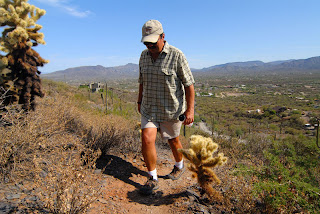
Hiking up the Black Mountain Trail past a bunch of teddy bear cholla. Don't let the name fool you; you wouldn't want to touch these teddy bears. It's only about 9:00 in the morning but the temperature is already in the high 90s.

Totally sweated out and standing on top of Black Mountain, a giant pile of fractured basalt. Behind me is a view looking southwest down Cave Creek Road.
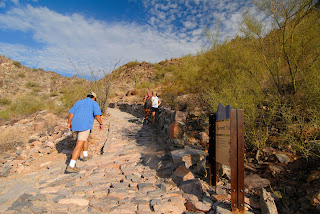
On Tuesday morning, Gene took me over to probably the most popular hike in the Phoenix area, Piestewa Peak (formerly Squaw Peak). It gets so much traffic that sections of the trail are covered with local stones laid like paving stones. Gene says the gentleman in the tank top talking to the woman in the white t-shirt is there every day, going up and down as many as three times.

The higher you go, the steeper it gets. This section of the trail is the final steep stretch before the summit. At least it was in the shade.

Totally sweated out and standing on top of Piestewa Peak, a giant pile of fractured granite. That's downtown Phoenix in the distance behind me.

Not-so-sweated-out Gene at the top of Piestewa Peak. I swear, the guy doesn't sweat at all, even carrying all that camera equipment. That's Black Mountain in the distance to the north, our hike from Sunday morning.

The trailhead for the Pinnacle Peak hike, which we did on Thursday morning. This hike would not take us to the top, which looks like it would be a fairly dangerous climb, but rather over the shoulder and around the backside for an out and back, some of it in shade.
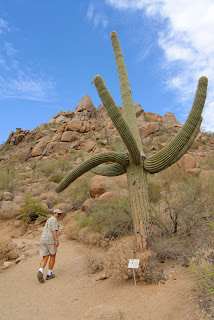
Attack of the giant saguaro!

On the backside of Pinnacle Peak, showing the gentle trail leading to the looming switchbacks in the shadow of the peak.
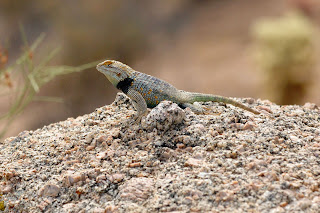
Gene likes to take what he calls "critter shots." This one is of a yellow-backed spiny lizard (Sceloporus uniformis) that we spotted while going up the switchbacks in the previous photo. He doesn't appear to be affected by the heat. Me, I was happy to get back to the relative cool of Grand Junction at the end of the week.
 Charlie turned ten years old today. Three months ago, when he was first diagnosed with cancer, we weren't sure if he would still be alive for his birthday, but his condition has stabilized somewhat in the past few weeks and it now seems that he will surpass our most optimistic expectations. We certainly hope so, because in exactly three weeks, we leave for our Odyssey sailing trip and we'll be gone for three full weeks. If he's not doing well before we go, we're afraid he might die before we return.
Charlie turned ten years old today. Three months ago, when he was first diagnosed with cancer, we weren't sure if he would still be alive for his birthday, but his condition has stabilized somewhat in the past few weeks and it now seems that he will surpass our most optimistic expectations. We certainly hope so, because in exactly three weeks, we leave for our Odyssey sailing trip and we'll be gone for three full weeks. If he's not doing well before we go, we're afraid he might die before we return.
 Raising Charlie: The Lessons of a Perfect Dog
Raising Charlie: The Lessons of a Perfect Dog













 On Tuesday morning, Gene took me over to probably the most popular hike in the Phoenix area, Piestewa Peak (formerly Squaw Peak). It gets so much traffic that sections of the trail are covered with local stones laid like paving stones. Gene says the gentleman in the tank top talking to the woman in the white t-shirt is there every day, going up and down as many as three times.
On Tuesday morning, Gene took me over to probably the most popular hike in the Phoenix area, Piestewa Peak (formerly Squaw Peak). It gets so much traffic that sections of the trail are covered with local stones laid like paving stones. Gene says the gentleman in the tank top talking to the woman in the white t-shirt is there every day, going up and down as many as three times.








